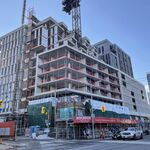Ford’s transit plan shortchanges suburbs, critics charge
Mar 07 2011
By Tess Kalinowski

Read More: http://www.thestar.com/news/transpo...ging-suburbs-with-transit-plan-critics-charge
Mayor Rob Ford’s transportation plan cheats Toronto’s suburbs of their fair share of $8.7 billion in provincial transit funds, according to the Toronto Environmental Alliance. TEA, which supports an older transit plan, says Ford’s underground proposal will mean less transit, to fewer riders. Only 217,000 commuters would benefit from light rail under Ford’s plan, which is still being considered by Metrolinx, the provincial agency that approves transit funding. That compares with about 460,000 commuters who could have accessed light rail under the old plan, which Ford has declared dead. TEA’s ridership numbers are based on the population living or working within 500 metres of the proposed light rail lines.
The “compromise” Ford plan, which calls for the entire Eglinton light rail line to be tunneled from Jane St. to the Kennedy subway station, is also more expensive, argues TEA. Its report, issued Monday, compares only the light rail covered by the $8.7 billion pledged by the province. TEA hasn’t included ridership on Ford’s proposed Sheppard subway extensions or any increase from more buses on Finch Ave. because neither accounts for any of the $8.7 billion in provincial funding. “There’s been a lot of skepticism of the mayor’s plan because there isn’t a plan yet,” said TEA spokesman Jamie Kirkpatrick.
.....
Really? This old song and dance again?
These numbers include the Jane LRT, but don't include Ford's Sheppard Subway proposal. If you're going to include fantasy lines that have little to no chance of ever being built, at least include them for both parts of the statistic.
EDIT: And where did this $8.7 billion number come from? Did the TEA pull a Rob Ford and include York Region's dedicated funding in there as well? I guess they're more alike than people are willing to admit. They both distort the facts, and they both suck at math.
Last edited:






